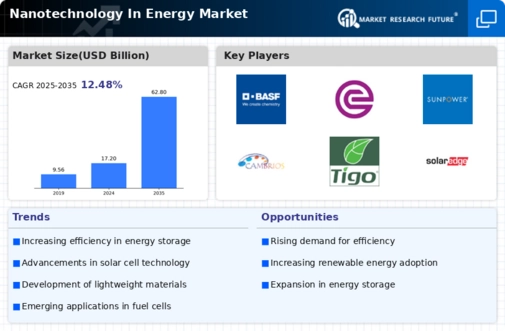Market Growth Projections
The Global Nanotechnology In Energy Market Industry is poised for substantial growth, with projections indicating a market size of 62.8 USD Billion by 2035. This growth is underpinned by a compound annual growth rate (CAGR) of 12.48% from 2025 to 2035, reflecting the increasing integration of nanotechnology in various energy applications. The market's expansion is driven by factors such as rising demand for renewable energy, advancements in nanomaterials, and government support for research and development. As the industry evolves, it is likely to witness the emergence of innovative solutions that leverage nanotechnology to address global energy challenges.
Advancements in Nanomaterials
Innovations in nanomaterials are propelling the Global Nanotechnology In Energy Market Industry forward. Nanomaterials, such as carbon nanotubes and quantum dots, exhibit unique properties that enhance energy storage and conversion processes. For example, these materials can significantly improve the efficiency of solar cells and batteries, leading to longer-lasting and more efficient energy solutions. As research progresses, the potential applications of nanomaterials in energy systems are expanding, suggesting a robust growth trajectory. The market is anticipated to grow at a CAGR of 12.48% from 2025 to 2035, indicating a strong future for nanotechnology in energy.
Government Initiatives and Funding
Government initiatives play a crucial role in shaping the Global Nanotechnology In Energy Market Industry. Various countries are implementing policies and providing funding to support research and development in nanotechnology for energy applications. For instance, the U.S. Department of Energy has allocated significant resources to promote nanotechnology research aimed at enhancing energy efficiency and renewable energy technologies. Such initiatives not only foster innovation but also create a conducive environment for the commercialization of nanotechnology solutions. This supportive framework is expected to contribute to the market's growth, with projections indicating a market size of 62.8 USD Billion by 2035.
Increasing Energy Efficiency Needs
The pressing need for energy efficiency is driving the Global Nanotechnology In Energy Market Industry. As energy consumption continues to rise globally, there is an urgent demand for technologies that can optimize energy use and reduce waste. Nanotechnology offers innovative solutions, such as advanced insulation materials and energy-efficient lighting, which can significantly lower energy consumption in various sectors. This trend aligns with global sustainability goals, prompting industries to adopt nanotechnology-driven solutions. The market's growth is indicative of this shift, as stakeholders recognize the potential of nanotechnology to address energy efficiency challenges effectively.
Rising Demand for Renewable Energy
The Global Nanotechnology In Energy Market Industry is experiencing a surge in demand for renewable energy sources. Governments worldwide are increasingly investing in sustainable energy solutions to combat climate change and reduce carbon emissions. For instance, the International Energy Agency projects that renewable energy capacity will continue to grow, with solar and wind energy leading the charge. This trend is likely to drive the adoption of nanotechnology in energy applications, enhancing efficiency and performance. By 2024, the market is expected to reach 17.2 USD Billion, reflecting the growing integration of nanotechnology in renewable energy systems.
Emerging Applications in Energy Storage
Emerging applications of nanotechnology in energy storage are reshaping the Global Nanotechnology In Energy Market Industry. With the increasing reliance on intermittent renewable energy sources, efficient energy storage solutions are becoming essential. Nanotechnology enhances battery performance through improved charge capacity and faster charging times. For instance, lithium-sulfur batteries, which utilize nanostructured materials, have shown promise in achieving higher energy densities compared to traditional lithium-ion batteries. As these technologies mature, they are likely to gain traction in the market, contributing to the anticipated growth trajectory of the industry.























